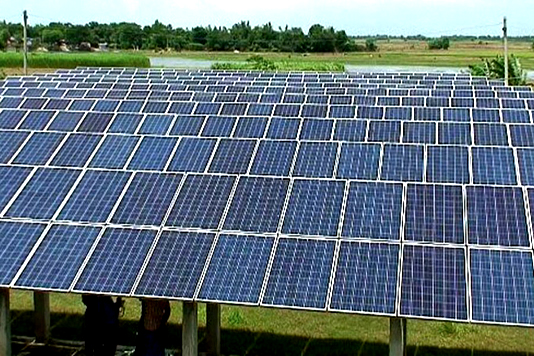By Dr Aynal Haque
RAJSHAHI, Sept 30, 2020 (BSS) – Installation works of solar home system in 6,240 off-grid char (riverbed) households in Rajshahi and Chapainawabganj districts are going on in full swing aimed at bringing the hard-to-reach families under solar power network within the shortest possible time.
The development works are being implemented in Char Mazar Diar and Char Khidirpur villages under Paba Upazila and Char Asariadaha village under Godagari Upazila in Rajshahi district and Char Alatali village under Sadar Upazila in Chapainawagonj district.
Northern Electricity Supply Company (NESCO) Limited has started implementing the solar home system installation works through the Infrastructure Development Company Limited (IDCOL) since September 21 last, said Yeaseer Arafat, Executive Engineer of NESCO.
Each of the beneficiary families can use four three-watt bulbs, two nine-watt fans, one 18 watt television and mobile phone charger through the 65-watt capacity solar home system, he added. “We are very much hopeful about completion of the works by November next”, he opined.
Similarly, solar home systems will also be installed in 6,212 other off-grid households of Hatibandha and Kaligonj Upazilas in Lalmonirhat district. Implementation works of the scheme are likely to start soon and complete until December next.
Engineer Arafat said the NESCO is committed to attain the present government’s target ‘Sheikh Hasina’s Uddyag, Ghore Ghore Bidyuth’ alongside the hundred percent electrification within the current Mujibborsho.
Meanwhile, solar power has brought a social change in many hard-to-reach villages under Char Ashariadaha Union Parishad (UP) in Godagari Upazila of the district.
Despite the problems of food and healthcare services the villages have become enlightened with uninterrupted electricity generated from solar panels.
The power also brings many positive changes to the living and livelihood condition of the villagers in many ways.
Talking to BSS solar power user Rahmat Ali of Char Bhubanppara said he could not even think about electricity an era ago though it has become a reality as the villagers there can avail of this facility.
UP Chairman Md Sanaullah told the agency that around 30,000 people live in the villages and 13,000 of them in six villages have power supply connections.
The beneficiary villages are: Ashariadaha, Panipar, Bhubanpara, Kanpara, Hanumantha Nagar and Nawshera.
He said the char villagers and owners of the solar power units either suffer from low-voltage nor load shedding and some of them are crushing paddy at nights using electricity from solar plants.
“The char people are watching television programmes to become aware of drugs, child marriage, malnutrition and dowry and using fans, bulbs and refrigerators, charging mobile phone sets, operating computers and doing other daily jobs,” Sanaullah added.
Housewives Monwara Begum of village Char Nowshera and Anjuara Khaatun of Char Hanumantanagar said they are getting uninterrupted supply of power using solar technology.
AVA Mini Grid Project commissioned 594 pieces of solar panels with financial initiative of IDCOL providing power supply to six villages scattered from the mainland by the Padma River.
“We had started the solar panel and supply line installation works with an estimated cost of around Taka 10 crore on November 6, 2015,” said Engineer Millat Hossain, Plant Manager of the project.
At present, the panels are generating 148.5 kilowatts electricity and the villages are getting power through the distribution line.
Engineer Hossain said the villagers are enjoying the power supply facilities through the prepaid card system and all of them are happy.
UP chairman Sanaullah said IDCOL has brought solar home systems to his villagers. The small solar panels provide enough electricity to charge a phone, run a fan, turn on a light or a TV for the evening hours.
Often, in fact, these solar panels perform better than the country’s electric grid, despite their shortcomings.
He added that the ability of households to earn an income from their solar systems through the nanogrid opens up innovative business possibilities.
For instance, households could reinvest their profits from solar energy trading to upgrade their solar technology to generate even more electricity and thus, profit.
Overnight, simple solar users are turned into smart entrepreneurs earning money real-time once their solar systems start producing a surplus of solar electricity.



